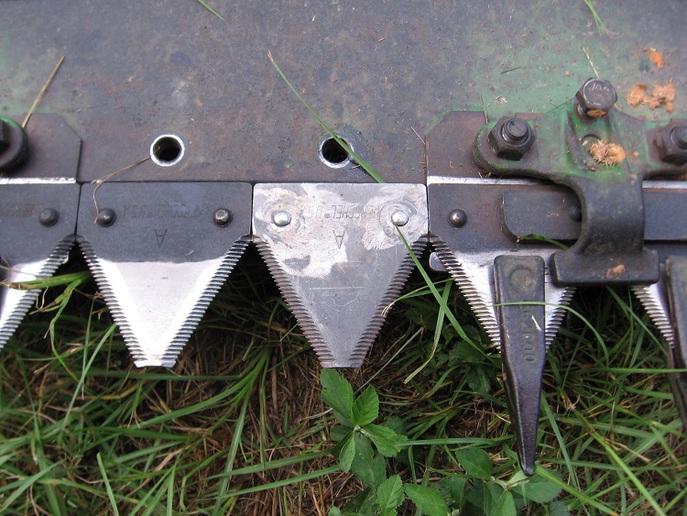I bought a 9' Deere 350 sickle mower , belt drive . I run it with a Ford 3000 3 cylinder diesel . It works great but seems a little heavy , but it really does a nice job for what I need .
I have about 30 acres of clear fields that I have kept mowed ( 5" rotary mower ) and have managed to get most of the bigger bushes eliminated . About 10 acres are nice and smooth with a mix of grasses , maybe half is clean Bermuda and the other half is heavy with sage grass . I have the sickle mower going this year and hope I can mow / bale often enough to get rid of most of the sage grass . I have a small 4x4 round baler .
I usually mow once or twice a year and plan on using the rotary mower on the rougher areas until I get them under control .
My question is about the sickle mower blades . I have replaced all of the bad rock guards ( singles ) and they have serrated blades on them . I received two extra Pittman arms ( if that is the correct term for the long bar with the teeth riveted on it ) . One has fair serrated blades , one has blades that have been ground down a lot , and one has smooth blades .
Is there a big difference in performance between under serrated , top serrated , and smooth blades ?
It is not a bad task for me to change the pittman arm section . I hit a small bush and buckled one , broke a few guards , and had to change it . The 20v 1/2 drive impact did most of the work for me .
I would not mind using one arm just for cutting hay and keeping it sharp , another for cleaning up the rougher stuff ( briars , etc ) if that is even necessary . Would I even want different style blades .
I have not used one before and all replies are welcome . I can sort through an find what works best for me , Thanks - Ken(Ark)
P.S. Yes I have spent hours picking up those golf ball sized rocks .
I have about 30 acres of clear fields that I have kept mowed ( 5" rotary mower ) and have managed to get most of the bigger bushes eliminated . About 10 acres are nice and smooth with a mix of grasses , maybe half is clean Bermuda and the other half is heavy with sage grass . I have the sickle mower going this year and hope I can mow / bale often enough to get rid of most of the sage grass . I have a small 4x4 round baler .
I usually mow once or twice a year and plan on using the rotary mower on the rougher areas until I get them under control .
My question is about the sickle mower blades . I have replaced all of the bad rock guards ( singles ) and they have serrated blades on them . I received two extra Pittman arms ( if that is the correct term for the long bar with the teeth riveted on it ) . One has fair serrated blades , one has blades that have been ground down a lot , and one has smooth blades .
Is there a big difference in performance between under serrated , top serrated , and smooth blades ?
It is not a bad task for me to change the pittman arm section . I hit a small bush and buckled one , broke a few guards , and had to change it . The 20v 1/2 drive impact did most of the work for me .
I would not mind using one arm just for cutting hay and keeping it sharp , another for cleaning up the rougher stuff ( briars , etc ) if that is even necessary . Would I even want different style blades .
I have not used one before and all replies are welcome . I can sort through an find what works best for me , Thanks - Ken(Ark)
P.S. Yes I have spent hours picking up those golf ball sized rocks .


